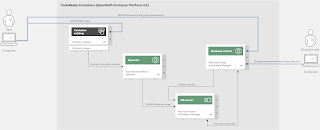 In our previous article from this series we introduced a use case around headless e-commerce for retail stores.
In our previous article from this series we introduced a use case around headless e-commerce for retail stores.
The process was laid out how we've approached the use case and how portfolio solutions are the base for researching a generic architectural blueprint.
Business optimisation architecture – Common architectural elements
 In my previous article from this series I introduced a use case around business optimisation for retail stores.
In my previous article from this series I introduced a use case around business optimisation for retail stores.
This article starts the real journey at the very top, with a generic architecture from which we'll discuss the common architectural elements one by one.
Blueprints review
As mentioned before, the architectural details covered here are base on real solutions using open source technologies. The example scenario presented here is a generic common blueprint that was uncovered researching those solutions. It's my intent to provide a blueprint that provides guidance and not deep technical details.
How to setup the OpenShift Container Platform 4.6 on your local machine
 Are you looking to develop a few projects on your local machine and push them on to a real OpenShift Container Platform without having to worry about cloud hosting of your container platform?
Are you looking to develop a few projects on your local machine and push them on to a real OpenShift Container Platform without having to worry about cloud hosting of your container platform?
Would you like to do that on one of the newer versions of OpenShift Container Platform such as version 4.6?
CodeReady Containers – Installing business automation operator (Part 4)
As a consistent user and developer on the OpenShift platform over the years, I've tried helping users by sharing my application development content as we've journeyed from cartridges all the way to container base development.
With container based development we've also transitioned from using templates to define how to deploy our tooling and applications, to operators. There are many examples of how to work with the templated versions of our applications around decision management and process automation found on Red Hat Demo Central and JBoss Demo Central.
CodeReady Containers – Building a Human Resources Process with an OpenShift Operator

Previously I've shared a cloud-native HR rewards process as an example project to run on the Openshift Container Platform.
What's the next evolution?
CodeReady Containers – Exploring a home loan mortgage process
Process automation developer tooling
 This article walks through installing the Red Hat Process Automation Manager on OpenShift Container Platform on your local machine using the provided operator. It's leveraging CodeReady Containers and delivers a fully functioning container-native development experience.This means upon logging in, you'll find a project ready to go and it delivers on the promise of a fully functioning developer process automation tooling containerized on your OpenShift Container Platform.
This article walks through installing the Red Hat Process Automation Manager on OpenShift Container Platform on your local machine using the provided operator. It's leveraging CodeReady Containers and delivers a fully functioning container-native development experience.This means upon logging in, you'll find a project ready to go and it delivers on the promise of a fully functioning developer process automation tooling containerized on your OpenShift Container Platform.
Install on CodeReady Containers
There are two options to install and run this project on the OpenShift Container Platform; use your own existing installation or to install on CodeReady Containers which provides you with a local OpenShift cluster.Ensure you have installed OpenShift with CodeReady Containers Easy Install
CodeReady Containers – Installing Business Automation Operator (Part 2)

As a consistent user and developer on the OpenShift platform over the years, I've tried helping users by sharing my application development content as we've journeyed from cartridges all the way to container base development.
With container based development we've also transitioned from using templates to define how to deploy our tooling and applications, to operators. There are many examples of how to work with the templated versions of our applications around decision management and process automation found on Red Hat Demo Central and JBoss Demo Central.
An Introduction to Red Hat OpenShift CodeReady Containers
Introduction to the Manual
This manual is made to guide you step by step in setting up an OpenShift cloud environment on your own device. It will tell you what needs to be done when it needs to be done, what you will be doing, and why you will be doing it, all in one convenient manual that is made for Windows users. Be warned however some system requirements are necessary to run the CodeReady Containers that we will be using. These requirements are specified within the chapter Minimum system requirements.
This manual is written for everyone with an interest in the Red Hat OpenShift Container Platform and has at least a basic understanding of the command line within PowerShell on Windows. Even though it is possible to use most of the manual for Linux or macOS we will focus on how to do this within Windows.
Red Hat Data Grid 8 for Beginners
What Is Data Grid ?
Data Grid is a high-performance, distributed in-memory data store. It stores all info in memory rather than on Disk or file that makes it faster. It is built from Infinispan open-source Software project and is available to deploy as an embedded library or as a standalone server.
Data Grid 8.0 Server
Data Grid 8.0 Server is isolated from Red Hat JBoss Enterprise Application Platform (EAP) and is re-designed to be lightweight and more secure with much faster start times. It is designed to create a running Data Grid cluster within few minutes with negligible configuration changes.
Code Ready Containers – Installing an HR employee rewards project using developer container catalog
If you've been following along here lately, you've noticed that I'm exploring Code Ready Containers quite a bit. I've been looking at how to run an OpenShift Container Platform, self-contained on my local machine with no more than 16GB of RAM.
It's not about just starting up the container platform, it's about doing something real with it. By real I am talking about running a demo, project, or some coding solution I enjoy tinkering with for my day job.
Code Ready Containers: Installing Process Automation
For some time now we've been working on updating your experience using Code Ready Containers, a container platform installation for your local machine, by providing interesting developer tooling and project examples.
There is no better way to learn about container technologies, container platforms, and container-based application development than getting hands-on with great open technologies.
Code Ready Containers: Getting Started With Cloud-Native Process Integration
I previously posted that I've started a refresh of the Red Hat Demo Central collection of AppDev in the Cloud projects by updating the Code Ready Containers Easy Install. As it promises, you'll have a local container platform cluster installed on your personal machine based on OpenShift Container Platform 4.2 in just minutes. The next step is to start leveraging this local container platform cluster for some cloud-native development experience, focusing on bringing all the existing content up to date.
This article outlines getting started with the HR Employee Rewards project on the above installation as default, though you can point this installation to any existing OpenShift Container Platform (pass an IP address). Let's take a look at how easy it is to get started with Code Ready Containers HR Employee Rewards Demo.
How to Set Up Container Development on Your Local Machine in Minutes
It's been a while since I've talked about running OpenShift Container Platform on your local machine.
This means a container platform at your finger tips, one you can use to experience the joys of cloud-native development and automated rolling deployments. Since I started pulling together ways to easily experience this with OpenShift Container Platform (back with version 3.3, believe it or not) we've come a long way.
Hybrid Cloud Infrastructure Labs Roadmap
Red Hat Summit 2019 is rocking Boston, MA from May 7-9th in the Boston Convention and Exhibition Center.
Everything you need to know about the current state of open-source, enterprise-ready software can be found at this event. From customers talking about their experiences leveraging open source in their solutions, to the creators of open-source technologies you're using, and all the way down to hands-on lab experiences on these technologies.

